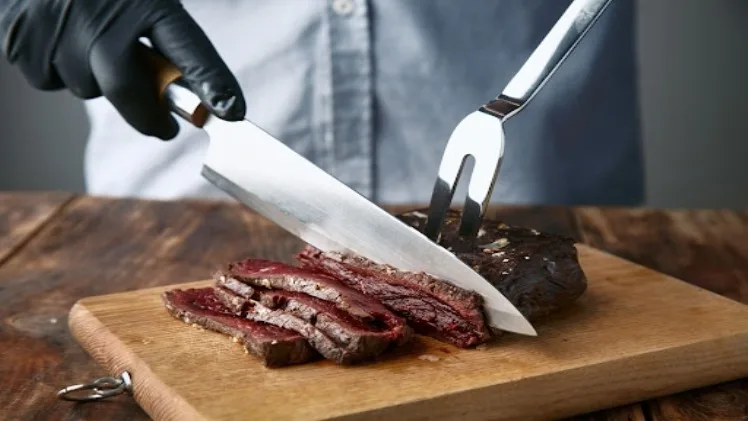Do you love a perfectly cooked steak? Do you enjoy the satisfaction of slicing through a juicy, tender piece of meat with ease? If so, then you know the importance of having the right knife for the job. Choosing the best knife for cutting steak can make all the difference in your dining experience.
When it comes to steak knives, there are a variety of options available on the market. With so many choices, it can be overwhelming to determine which knife is the best fit for your needs.
Key Takeaways
- Factors to consider when selecting a steak knife include blade material, rust resistance, blade thickness, serration options, blade size and shape, and blade tip.
- The handle design is important for a comfortable and secure grip, and budget is a factor to consider when selecting a steak knife.
- Proper maintenance is crucial for keeping steak knives sharp and durable, including regular sharpening using honing rods, sharpening stones, or electric sharpeners.
- Researching top brands and reading customer reviews can help ensure the quality of the knife, and personalized recommendations from experts can also be helpful in choosing the best knife for cutting steak.
Consider the Blade Material
When choosing the best knife for cutting steak, it’s important to consider the blade material because different materials offer varying levels of sharpness, durability, and ease of maintenance.
Blade hardness is an important factor to consider when selecting a steak knife. Harder blades, such as those made from high-carbon stainless steel, hold their edge longer and require less sharpening over time. Additionally, look for blades with good rust resistance to ensure longevity and avoid the need for frequent replacements.
Another crucial aspect to consider is blade thickness and serration options. Thicker blades are more durable and can withstand the pressure of cutting through a thick steak, while serrated blades are ideal for cutting through tougher meats.
A serrated edge also helps to grip the meat, providing a cleaner cut and preventing the blade from slipping. A non-serrated edge is still a good choice when looking for a knife to cut meat, but steak specifically is fairly tough.
Evaluate Blade Size and Shape
The size and shape of the blade can make a world of difference in how effortlessly the meat is sliced. A curved blade, for instance, provides a smooth, continuous cut that makes for an enjoyable dining experience. When selecting a knife for cutting steak, it’s important to evaluate blade size and shape. Here are some factors to consider:
- Blade length: The ideal length of a steak knife blade is between 4-6 inches. This length ensures that you have enough blade to slice through the meat, while also being easy to maneuver.
- Blade shape: A pointed tip is ideal for precision cuts, while a rounded tip is better for safety and stability. Additionally, a serrated edge can make it easier to cut through tough meats.
- Blade sharpness: A dull blade can ruin the dining experience by shredding the meat, while a sharp blade ensures a clean cut. Make sure to choose a knife with a sharp blade that can be maintained over time.
Handle Design
You want to look for a knife with an ergonomic grip, which means it’s designed to fit comfortably in your hand and provide a natural grip. A well-designed handle will reduce the risk of slipping or losing control of the knife while cutting your steak.
Additionally, you should consider the texture options available for the handle. A handle with a smooth texture may feel slippery in your hand, especially if your hands are wet or greasy. On the other hand, a handle with a rough texture may feel uncomfortable to hold for an extended period.
Look for a handle with a texture that feels secure in your hand without being too rough or too smooth. By evaluating the handle design and texture options, you can ensure that you choose a knife that feels comfortable in your hand and provides a secure grip for the safe and efficient cutting of your steak.
Determine Your Budget
When determining your budget for a steak knife, it’s important to consider the price range and factors that affect the cost.
The price range for steak knives can vary greatly, with some options costing only a few dollars, while others can cost hundreds of dollars.
Factors that can affect the price of a steak knife include the materials used, the level of craftsmanship, and the brand name.
Price Range for Steak Knives
Looking for a great steak knife without breaking the bank? Check out our selection of affordable options!
When it comes to the price range for steak knives, there are several factors to consider. Top brands may come with a higher price tag, but they often come with a reputation for durability and high-quality materials. On the other hand, there are also budget-friendly options that can still provide a decent cutting experience.
When choosing a steak knife, it’s important to think about how often you will be using it and what kind of steak you will be cutting. If you plan on using it frequently or cutting through tougher cuts of meat, it may be worth investing in a higher-end option. However, if you only use it occasionally or for thinner cuts of meat, a more affordable option may suffice.
Read Reviews and Compare Brands
Reviews can be quite helpful. You can find reviews on various websites such as Amazon, Reddit, and even on the product page. Reviews can give you an idea of the experience that others have had while using the knife.
Caring for Your Steak Knives After Purchase
Taking care of your new steak knives is essential to ensure they remain sharp and durable for all your future dining experiences. Proper maintenance is the key to keeping your knives in tip-top shape.
After each use, wash your knives with warm water and soap, and dry them thoroughly with a soft cloth. Avoid putting them in the dishwasher as the high heat and harsh detergents can damage the blades and handles.
Regular sharpening is also crucial to maintain the quality of your steak knives. There are several sharpening techniques you can use, such as honing rods, sharpening stones, and electric sharpeners. Honing rods are used to straighten out the blade’s edge while sharpening stones remove any nicks or chips in the blade. Electric sharpeners are the most convenient option, but they can also be the most expensive.
No matter which method you choose, make sure to follow the manufacturer’s instructions carefully. With proper care and maintenance, your steak knives will remain sharp and reliable for many meals to come.
Frequently Asked Questions
Can any type of knife be used for cutting steak?
Using the wrong type of knife for steak cutting is a common mistake. While any knife can cut steak, serrated blades are better for tough meats, while straight blades offer precision. Consider the pros and cons before choosing.
How do I know if the handle is comfortable to hold?
To determine if a knife handle is comfortable, pay attention to handle ergonomics and grip texture. Look for a balanced and maneuverable knife that feels secure in your hand. Choosing a knife that fits comfortably will enhance your dining experience.
Is it better to choose a serrated or straight-edge blade for cutting steak?
Serrated blades are good for tough cuts, but can tear meat. Straight blades provide clean cuts but require more effort. Factors affecting performance include blade length, weight, and material.
Are there any special maintenance tips for keeping a steak knife in good condition?
To keep your steak knife in good condition, sharpen it regularly using a honing rod or sharpening stone. Clean it after each use with warm, soapy water and dry it immediately. Avoid soaking or putting it in the dishwasher.
How important is the weight of the knife when it comes to cutting steak?
When it comes to cutting steak, the weight of the knife is important as it affects the knife balance. A heavier knife may tire your hand quickly. Blade thickness is also a factor affecting steak cutting.



